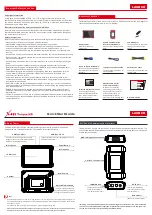
Maintenance
Instructions for use
|
Dräger BG ProAir
23
5.2.6.2 Overview of function and leak test
1. Preparing the test
(see "Preparing the test", page 23).
2. Checking the exhalation valve
(see "Checking the exhalation valve", page 23).
3. Checking the inhalation valve
(see "Checking the inhalation valve", page 23).
4. Checking the drain valve
(see "Checking the drainage valve", page 23).
5. Leak-tightness test with positive pressure
(see "Leak-tightness test with positive pressure",
page 23).
6. Checking the relief valve
(see "Checking the relief valve", page 23).
7. Checking the response of the no-oxygen alarm
(see "Checking the response of the no-oxygen alarm",
page 23).
8. Checking the pre-flush unit
(see "Checking the pre-flush unit", page 24).
9. Carrying out the high-pressure leak test
(see "Performing the high-pressure leak test (incl.
constant dosage device)", page 24).
10. Checking the bypass
(see "Checking the bypass", page 24).
11. Checking the minimum valve
(see "Checking the minimum valve", page 24).
12. Checking low-pressure alarm 1
(see "Checking low-pressure alarm 1", page 24).
13. Close the closed-circuit breathing apparatus.
5.2.6.3 Preparing the test
1. Switch on the test unit: Press the
button.
2. Set the selector switch on the test unit to
.
3. Position the closed-circuit breathing apparatus and test
unit next to each other so that both devices are easily
accessible and the test unit can be operated easily.
4. Open the lid or remove it (see "Opening the closed-circuit
breathing apparatus", page 16).
5. Remove the protective cap from the connecting piece and
insert the connecting piece into the test unit.
6. Perform tests.
5.2.6.4 Checking the exhalation valve
1. Set the selector switch on the test unit to
.
2. Tightly pinch the inhalation hose with your hand. Use the
face spanner from the BG ProAir Test Set if necessary.
3. Pump once. The test unit must display at least -10 mbar or
"Sensor out of range".
4. If -10 mbar is not reached, replace the exhalation valve or
the exhalation valve disc.
5.2.6.5 Checking the inhalation valve
1. Set the selector switch on the test unit to
.
2. Tightly pinch the exhalation hose with your hand. Use the
face spanner from the BG ProAir Test Set if necessary.
3. Pump once. The test unit must display at least +10 mbar
or "Sensor out of range”.
4. If +10 mbar is not reached, replace the inhalation valve or
the inhalation valve disc.
5.2.6.6 Checking the drainage valve
1. Set the selector switch on the test unit to
.
2. Flip the locking lever in the spring bridge and position it so
that the pressure plate is blocked by the locking lever.
3. Pump until the pressure plate on the spring bridge pushes
against the locking lever.
4. Continue to pump until flow noises can be heard at the
drainage valve and read the value on the display. The
drainage valve must open b10 mbar and
+25 mbar.
5.2.6.7 Leak-tightness test with positive pressure
1. Set the selector switch on the test unit to
.
2. Reduce the pressure on the test unit using the venting
button to 7+0.5 mbar and wait until the pressure has
stabilised.
3. Press
to start the timer.
The test time must be 1 minute. When the test time has
elapsed, the pressure difference is displayed. The
pressure difference must not be greater than 1 mbar.
5.2.6.8 Checking the relief valve
1. Set the selector switch on the test unit to
until the
locking lever can once again be moved.
2. Latch the locking lever in the spring bridge once again.
3. Set the selector switch on the test unit to
.
4. Pump until flow noises can be heard at the relief valve.
Read-off the value on the display.
The relief valve must open b4 mbar and +8 mbar.
5.2.6.9 Checking the response of the no-oxygen alarm
1. Set the selector switch on the test unit to
.
2. Pump on the test unit until the no-oxygen alarm sounds
and the
symbol appears.
The warning stops after a few seconds, as the respiration
is only simulated and no respiration occurs. The
Connect ECU automatically switches back to Standby
mode.
If the closed-circuit breathing apparatus has been laid
out for too long, the Connect ECU will be in Eco mode and
no alarm will be triggered. Place the apparatus in an
upright position and then lay it down again. The
Connect ECU is then in Standby mode and the test can be
repeated.
OK
OK
Summary of Contents for BG ProAir
Page 2: ......
Page 31: ...Annex Instructions for use Dr ger BG ProAir 31...
Page 32: ......
Page 33: ......












































